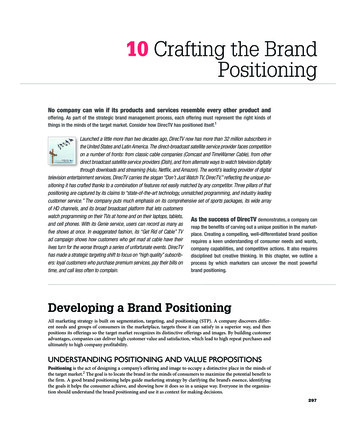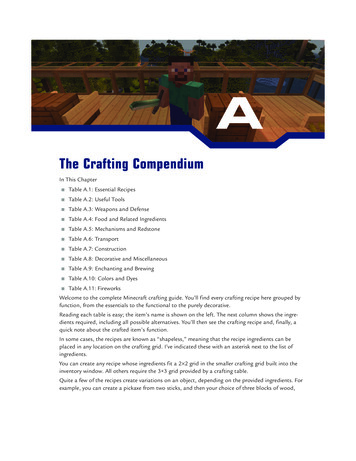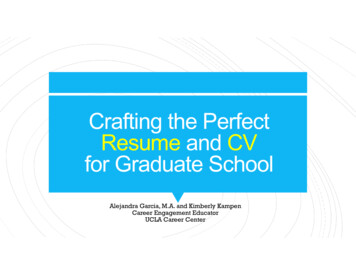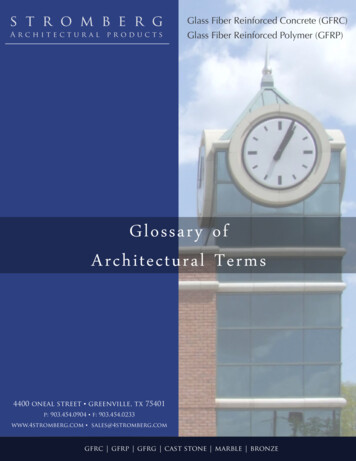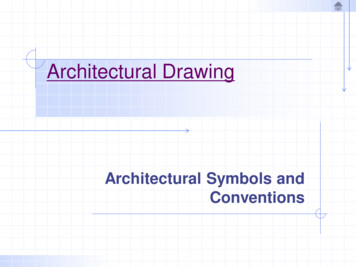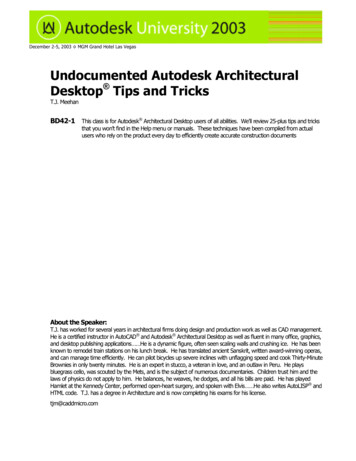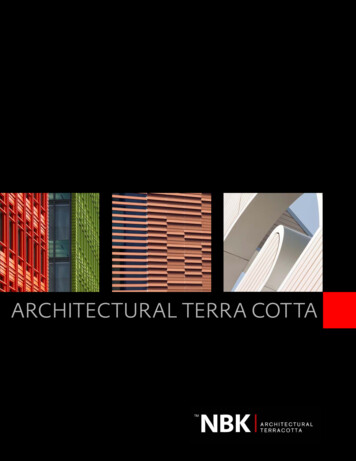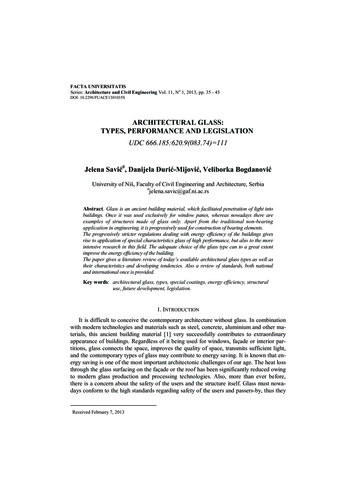
Transcription
crafting an architecturalPORTFOLIOIIT Academic resource centerHannah RosenthalFebruary 2012
introThis workshop covers the basics of creating an architectural portfoliothat will not only get you noticed by schools and firms, but will neatlydisplay your work to people without architectural backgrounds. Purpose and content Print vs. Digital vs. Online Software Using Text Example IIT Undergraduate Portfolio Resources
Purpose and contentWhy?Architectural portfolios are requested by firms and educationalinstitutions to predict applicant success within their company orprogram.Who?Before considering what to include in your portfolio, the first questionto answer is “who is my audience?” If you want to work for a firm thatspecializes in a particular building type or architectural methodology,make sure to show work that demonstrates your familiarity with orinterest in that area.What?Every student will graduate with dozens of studio projects, drawings,and design pieces that demonstrate their creativity. Try your best tofilter through your work and display your best 5 projects. Make surethey fit together as a whole to demonstrate flexibility in programs andproblem solving.
Print vs. Digital vs. OnlinePrintIn the past, students have compiled double‐sided, bound booklets topresent their work. This is generally requested by institutions in an8‐1/2”x 11” or 11” x 17” format. However, page size and binding can varydepending on how you want to express your work.Digital pdfIn recent years, architecture firms and students alike have beenswitching from paper portfolios to digital presentations. Afterassembling a pdf portfolio in Adobe Acrobat, you can easily e‐mail thatto firms and institutions.OnlineNearly every firm today has a website to display their past projects.BIG: http://www.big.dk/SOM: http://www.som.com/content.cfm/www projects?sort by FWStudents have also begun to create websites with online /undergraduate‐portfolio/
SoftwareAdobe InDesignAdobe InDesign is the best program by Adobe for compiling a multi‐page document like an architectural portfolio. You can set up two‐pagespreads to view your work as if it were printed, automate pagenumbers, implement font and character styles so it is easier to changefonts later in the process, and “link” your images, which keeps your filesize manageable for the average desktop.Adobe Illustrator and PhotoshopMany students also like to use Illustrator and Photoshop to compiletheir portfolio. Though these programs have their advantages, it is bestto use them to edit drawings, diagrams, and images which can then beplaced into an InDesign document.You can download free trials of these programs on the Adobe website:http://www.adobe.com/downloads/
Adobe InDesign
PreziA new type of digital presentation has emerged that disregards conventionand creates a more interactive experience for the audience. This online toolcould be a great way to compile and express your architectural work.Sample presentation: http://prezi.com/9zj tyve4dyb/how‐to‐change‐education
The best part? It’s free for students!
Using TextLess is MoreBecause architecture is a visual and spacial art, your pictures,renderings, and diagrams will always be more important than your text.Do compliment your images with a few sentences about each projectthough, so you can give the viewer clues about the design problem,your process, and the final solution. Remember, no one will appreciateyour work if they cannot understand it.How many fonts?To give your various projects a sense of cohesion, stick with two orthree font styles. Adobe programs offer flexibility on letter stretching,underlining, italicizing, shadowing and more so you can jazz up thosefew styles. Be creative but keep it clean. You want a potential employerto analyze your work not your fonts.You can download free fonts from dafont.com: http://www.dafont.com/
Example PortfolioFrom an IIT Undergraduate
HANNAH ROSENTHALILLINOIS INSTITUTE OF TECHNOLOGYARCHITECTURE INTERN3340 S MICHIGAN AVECHICAGO, IL 60616
PLANETOPLANE TRANSITIONThis transition from verticalto horizontal plane exploresthe multiple relationships between light, dark, expansive,and compressed space.The path fluctuates betweencompressed, dark areas andexpansive, light areas, crescendoing into the most light,expansive space at the horizontal plane. Various objectspenetrate surfaces along thepath to invoke mystery andpull occupants along the spiraling transition. The size ofeach individual object wasbased on a pre-determinedkit of parts.Detail on upper-level of southeast elevation.2:28Southeast elevation of basswood and MDF model. (December 2007)
Northeast elevationNorthwest elevation3:28
LAKE MICHIGAN WRITER’S STUDIOThis small writer’s studio iscomposed of an open workarea, kitchen, bathroom,and entry closet. The spaceexpresses IIT’s tradition ofusing minimal materials tomaximize architectural effect.Hand-drafted graphite on Strathamore board. (November 2008)4:28
LAKE MICHIGAN SUMMER RESIDENCEThis summer home blursthe line between interior andexterior spaces. The divisionof the public and privatespaces into distinctive unitscreates multiple lakeshoreviews and preserves theBeech tree in the middleof the property. The treeis incorporated into thedesign as a natural umbrellafor the courtyard, whichis centralized to serve thefamily’s private unit and thepublic unit intended for largegatherings.View of central courtyard looking toward hearth in basswood, acrylic, and cork model. (May 2009)5:28
6:28
7:28
LOUNGE CHAIR TABLEThis table was inspired byMies’ Carr Chapel, located onthe IIT campus in Chicago.The small form of Carr Chapelis derived from the goldenrectangle, using the perfectproportion in both sectionand plan. This table is alsoproportioned according tothe ideal ratio. It is designedto complement a lounge chairsuch as Mies’ BarcelonaChair, originally designed in1929. The table is also areaspecific. The dimensions ofthe piece directly correspondto a standard moleskinsketchbook, a typical drinkingglass, and a pencil. Thetable consists of a laminatedPoplar base and foldedacrylic appendage.8:28
MEXICO HOUSE BUILDINGI’ve traveled to Jaurez andAcuña, Mexico three times inthe past seven years to buildhomes with Casas por Cristo.During the summer of 2010I realized that the mostsustainable way for poorfamilies to live in safe, wellconstructed environments isby teaching them to designand build like architects andengineers.Construction team in front of a completed home in Acuña. (July 2010)10:28Applicant (front) and her sister preparing to move lumber. (June 2006)
PARIS HOMELESS SHELTERThe site for this shelter isadjacent to the Parc de Belleville, where many homelesspeople sleep in tents or onpublic benches. The shelteris comprised of four, two-story blocks that each contain apublic bathroom, public living room, semiprivate kitchenarea, and private bedrooms.Arranging these facilities intoa block integrates the external and internal communities,creating relationships between rent-paying residentsthat sleep in the bedroomsand their homeless neighborswho use the public facilities.In combination with a chapeland programs hosted in theadminsitrative building, theserelationships are intended tohelp meet the spiritual, physical, social, and intellectualneeds of the homeless.A homeless man sleeping on a bench in the Parc de Belleville. (September 2010)Baby-sitting for the daycare at the Foyer de Grenelle, a homeless shelter in central Paris. (October 2010)11:28
PROGRAM DEVELOPMENTR GRAM D VM Luxury
CConceptual cartoon demonstrating external integration through building circulation.INTERNALEXTERNAL13:28
1st floor1stfloorSite androofroofplan planSiteand14:28Latitudinal sectionsectionthrough bothblocks, elevatedand ks,elevatedchapel, and central courtyard.2nd floor2ndfloor
3rd floor3rdfloor4th floor4thfloor5th floor5thfloor6th floor6thfloorInternalLongitudinal section through both southern blocks and the administrative building.Longitudinalsection through both southern blocks and the administrative building.Internal andexternal15:28
ALTERNATIVE PATHTOPARCDEBELLEVILLE ENTRANCEView of administrative building facade and courtyard entry from the main street.16:28View of external passerby checking for mail at her mailbox.
View of passerby meeting an internal resident in the central courtyard. The park entrance is seen in the background. View of external and internal persons deviating from the path to the park and entering the chapel elevator together.17:28
EDGE: ELLIOT DONNELLY GARDENING ECO-CENTERA team of IIT students andfaculty designed this projectfor an empty lot adjacentto the Elliot Donnelly YouthCenter in Chicago in Spring2011. The team created thisthree classroom sustainablelearning center to serve asan educational tool for theyouth and community atlarge. The building promotesenviornmental literacy byimplementing passive designstrategies such as solarthermal heating, naturalventilation, rainwater cisterns,PV panels, rain gardens, agreen roof, raised beds forgardening, an orchard, andtwo masory, thermal masswalls that also guide thebuilding organization. Theteam worked with Architecturefor Humanity representativesand the clients at the youthcenter to produce a full set ofconstruction documents anda publication for potentialdonors.18:28
Section through classroom and entry area.Section through bathroom, lobby, and greenhouse.19:28
EDGE: INTERACTIVE STAIR20:28My most significant contribution to the group project came from designing the interactive stair component in the central lobby. Research of theBronzeville neighborhood in Chicago revealed an undeniable influence of jazz music on the culture of the community. Louis Armstrong, one of themost innovative jazz musicians who ever lived, worked and performed regularly in this neighborhood. To celebrate the rich heritage of the Bronzevillecommunity and allude to the beauty of the natural enviornment, the form of these stairs was transcribed from the melody of Armstrong’s piece “Whata Wonderful World.” The cork steps are intended to be used as a gathering place for students or tour-groups, with concrete paths interspersed forcirculating between levels.
MUSICAL NOTES-COLOR CORRESPONDENCESIN THEVISIBLE SPECTRTUMOFLIGHTNewton’s theory of color was used to transcribed audible frequencies into visual frequencies.The musical phrases were stacked into stairs according to the overlapping of notes in each part.Interior rendering of Google Sketch-up model looking westward.Interior rendering of Google Sketch-up model looking eastward.
BARNSWORTH EXHIBITION CENTERBuilt in Plano, IL between1945-51, Mies van derRohe’s well-known house forDr. Farnsworth is visited byhundreds of architects andtourists each year. With hopesof attracting more visitors,a 500 SF exhibition spacewas designed to complimentthe existing visiting center,which is located a milewalk from the home. IITfaculty and students workedcollectively to design andconstruct the “Barnsworth”Exhibition Center to fit withthe agricultural backdrop ofrural Illinois, mimicking thetraditional form of a silo.Mymostsignificantcontribution to the projectwas an energy reductionanalysis conducted in aprogram entitled IntegratedEnvironmentalSolutions(IES). Using Energy Star’sTarget Finder and the IESsoftware, energy reductiongoals were estabilished andfive energy-saving designstrategies were measured. Allfive strategies were combinedin the final model, whichsuccessfully reduced energyusage by nearly 76%. Closingthe building during the winterand adding a lantern for daylighting proved to be themost effective, applicablestrategies.22:28ANNUAL ENERGY CONSUMPTIONBASELINE ANNUAL ENERGYCONSUMPTIONFINAL ANNUAL ENERGYCONSUMPTION
Difference from -96%Baseline-39%--35%35%-39%-96%--76%76%
PRIVATE RESIDENCE RENNOVATIONSWITHROHRBACH ASSOCIATES PCSince the summer of 2008,I have worked alongsideprofessionals at RohrbachAssociates, PC in IowaCity, Iowa on three privateresidences. My role in theschematicdesignwasminimal, but I sat in on clientmeetings, made physicalmodels, developed digitalmodels in Google sketchup, and helped produceconstruction documents. Ihave also helped produceowner manuals, sketch-upmodels, and constructiondocuments for numerousother projects for the firm.Northwest view of basswood model built at 1/8” 1’-0” (June 2008)24:28Google sketch-up model of Smith residence (August 2008)
Existing north facade of Schmedeke residenceGoogle sketch-up model of Schmedeke porch addition (July 2010)25:28
INDIA ORPHANAGEANDFor six weeks during thesummer of 2011, I had thepriviledge of volunteeringas a project intern with Engineering Ministries International in Musoorie, India. Wecompleted a project for anon-profit Christian ministryin a small village outside ofHyderabad. Our team, consisting of four architects andthree civil engineers, spenta week with our client completing conceptual designwork for a new orphanagefor 100 children and a churchbuilding for 300 people. Theproject was designed to beinstalled in multiple phases,the last of which will consistof a primary school. The initialphase of construction documents and fund-raising materials were completed duringthe latter half of the internshipafter returning to the company office.WITHCHURCHENGINEERING MINSITRIES INTERNATIONALExisting orphanage facilities in Guttapal, India. (June 2011)View from existing facilities of the grazing area and hills to the west.The church building implements traditional brick jali walls and open-air courtyards for natural ventilation.26:28
27:28
HANNAH ROSENTHALUPDATED DECEMBER 2011
resourcesPortfolio CreationAlex tion/Adobe Downloa
intro This workshop covers the basics of creating an architectural portfolio that will not only get you noticed by schools and firms, but will neatly



